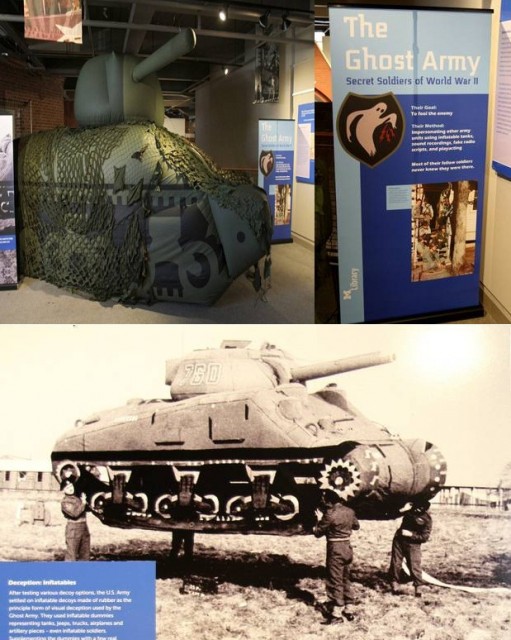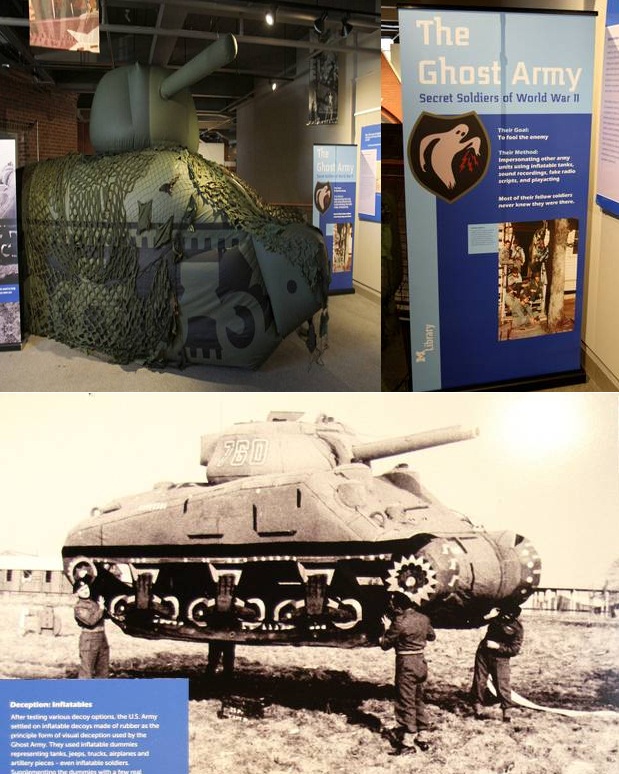
Yes, they look like airbeds or even the bouncy houses one rents for a kid’s birthday party but these inflatable tank – just one of the many with some reaching eight feet in height – was a prop used by the Ghost Army, the secret ‘air’ tactic the Americans used to deceive the Nazis in WWII.
The Museum of Work and Culture in Woonsocket displays an inflatable tank, a replica of the original ones used by the Ghost Army to trick the Nazis saving thousands of American lives in the process.
The Ghost Army was in fact the 23rd Headquarters Special Troops – it was special because its over 1,000 members were not US soldiers to the core; most of them were actors and artists sent on mission to impersonate the United States Army divisions during WWII. Their job was to trick the enemies,, be the tactical deception buying time for the real troops to sneak in and do the real thing.
America’s inspiration for its WWII Ghost Army was from its closest ally, Britain. The British Army had utilized the same deception scheme in 1942 for the Battle of El Alamein.
Members of the 23rd Headquarters Troop used inflatable tanks, trucks, airplanes, command posts, trucks and soldiers as well as false radio traffic, sound effects and stencils duplicated tires, emblems and shoulder patches. Along with these props, they brought along with them their clever talents in showmanship for their “road shows”. Throughout WWII, they were able to stage over 20 battlefield frauds most of which were operated close to the front lines.
The truth about the Ghost Army was just a recent discovery – it was only in 1996 when the story about this top-secret unit leaked out. As a matter of fact, some of its aspects are still classified.
In a mission, among the last of the two dozen they did during WWII’s last moments, their “show” aided the the 9th Army to cross the Rhine River and get into Germany’s center. As what the poster board at the Woonsocket exhibit states, the Viersen deception had roughly saved about 12,000 American lives.
“It’s just amazing what that generation did,” said state Rep. Stephen M. Casey about the Ghost Army.
Woonsocket’s Role in the Ghost Army
Mill workers from Woonsocket made much of the props used by the Ghost Army though they did not know that was really the purpose of the equipment they were producing at that time. The young women working at U.S. Rubber Co. in the Alice Mill were paid 49 cents per hour of work but were told the dummies were going to be used for target practice.
There were also other mill workers coming from areas around the city as well as artists helping but it was the development engineer of U.S. Rubber, Fred Patten, who designed the inflatable tank, the one-man life rafts and many others.
Woonsocket had about over 100 mills running during the height of the textile industry and according to local historians, the mills’ work was not only critical to the nation’s military during WWII but it was also important for the economy of the city.
Historians further added that the former Alice Mill which was established in 1889, and currently is considered a Woonsocket landmark, was the biggest rubber mill in the whole world in those times with its 1,000 workers.
Though the complex in Fairmount Street had been destroyed by fire three years ago and most of the mills around the city had either been closed down, burned or re-purposed as housing developments, Woonsocket’s history continues to live on in the two-story Museum of Work and Culture. The building the museum is in was once a mill itself – established in 1915, it used to house the Barnai Worsted Company which manufactured men’s fine clothing and military garments made of wool.
Museum visitors can stand inside the parlor of the apartment house and listen to recordings of the edifice’s former residents from the bygone days, individuals who only wore their good pair of shoes on Sundays. They will also come to learn that French Canadian had come in packs to work in the area and buy farmlands. They may even come in contact with an Old Catholic school teacher who would stress out that “cleanliness is next to Godliness”.
And then they can pay a visit to the replica of a mill factory where mule spinners worked on a mule machine to make threads and women were paid 49 cents to make equipment for the Ghost Army who in turn, helped save thousands of American lives.
